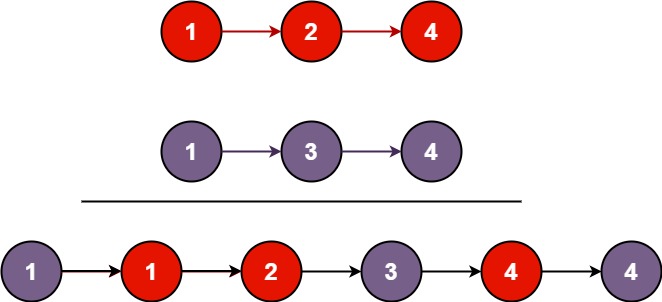上次编辑到这里,代码来自缓存 点击恢复默认模板
/**
* Definition for singly-linked list.
* struct ListNode {
* int val;
* ListNode *next;
* ListNode() : val(0), next(nullptr) {}
* ListNode(int x) : val(x), next(nullptr) {}
* ListNode(int x, ListNode *next) : val(x), next(next) {}
* };
*/
class Solution {
public:
ListNode* mergeTwoLists(ListNode* list1, ListNode* list2) {
}
};
python3 解法, 执行用时: 40 ms, 内存消耗: 16.2 MB, 提交时间: 2023-08-05 23:24:45
# Definition for singly-linked list.
# class ListNode:
# def __init__(self, val=0, next=None):
# self.val = val
# self.next = next
class Solution:
def mergeTwoLists(self, list1: Optional[ListNode], list2: Optional[ListNode]) -> Optional[ListNode]:
if list1 == None:
return list2
if list2 == None:
return list1
list3 = None
if list1.val < list2.val:
list3 = list1
list3.next = self.mergeTwoLists(list1.next, list2)
else:
list3 = list2
list3.next = self.mergeTwoLists(list1, list2.next)
return list3
golang 解法, 执行用时: 0 ms, 内存消耗: 2.5 MB, 提交时间: 2021-07-21 10:48:46
/**
* Definition for singly-linked list.
* type ListNode struct {
* Val int
* Next *ListNode
* }
*/
func mergeTwoLists(l1 *ListNode, l2 *ListNode) *ListNode {
if l1 == nil {
return l2
}
if l2 == nil {
return l1
}
var l3 *ListNode
if l1.Val < l2.Val {
l3 = l1
l3.Next = mergeTwoLists(l1.Next, l2)
} else {
l3 = l2
l3.Next = mergeTwoLists(l1, l2.Next)
}
return l3
}
php 解法, 执行用时: 16 ms, 内存消耗: 15.5 MB, 提交时间: 2021-05-28 14:46:01
/**
* Definition for a singly-linked list.
* class ListNode {
* public $val = 0;
* public $next = null;
* function __construct($val = 0, $next = null) {
* $this->val = $val;
* $this->next = $next;
* }
* }
*/
class Solution {
/**
* @param ListNode $l1
* @param ListNode $l2
* @return ListNode
*/
function mergeTwoLists($node1, $node2) {
$prehead = new ListNode(-1);
$prev = $prehead;
while ( $node1 != null && $node2 != null ) {
if ( $node1->val <= $node2->val ) {
$prev->next = $node1;
$node1 = $node1->next;
} else {
$prev->next = $node2;
$node2 = $node2->next;
}
$prev = $prev->next;
}
$prev->next = $node1 == null ? $node2 : $node1;
return $prehead->next;
}
}
javascript 解法, 执行用时: 100 ms, 内存消耗: N/A, 提交时间: 2018-08-29 13:26:30
/**
* Definition for singly-linked list.
* function ListNode(val) {
* this.val = val;
* this.next = null;
* }
*/
/**
* @param {ListNode} l1
* @param {ListNode} l2
* @return {ListNode}
*/
var mergeTwoLists = function(l1, l2) {
if ( l1 == null ) return l2;
if ( l2 == null ) return l1;
var l3 = ListNode(0);
if ( l1.val < l2.val ) {
l3 = l1;
l3.next = mergeTwoLists(l1.next, l2);
} else {
l3 = l2;
l3.next = mergeTwoLists(l1, l2.next);
}
return l3;
};
cpp 解法, 执行用时: 12 ms, 内存消耗: N/A, 提交时间: 2018-08-29 13:24:47
/**
* Definition for singly-linked list.
* struct ListNode {
* int val;
* ListNode *next;
* ListNode(int x) : val(x), next(NULL) {}
* };
*/
class Solution {
public:
ListNode* mergeTwoLists(ListNode* l1, ListNode* l2) {
if ( l1 == NULL ) return l2;
if ( l2 == NULL ) return l1;
ListNode* l3 = NULL;
if ( l1->val < l2->val ) {
l3 = l1;
l3->next = mergeTwoLists(l1->next, l2);
} else {
l3 = l2;
l3->next = mergeTwoLists(l1, l2->next);
}
return l3;
}
};
golang 解法, 执行用时: 8 ms, 内存消耗: N/A, 提交时间: 2018-08-29 13:20:51
/**
* Definition for singly-linked list.
* type ListNode struct {
* Val int
* Next *ListNode
* }
*/
func mergeTwoLists(l1 *ListNode, l2 *ListNode) *ListNode {
if l1 == nil {
return l2
}
if l2 == nil {
return l1
}
var l3 *ListNode
if l1.Val < l2.Val {
l3 = l1
l3.Next = mergeTwoLists(l1.Next, l2)
} else {
l3 = l2
l3.Next = mergeTwoLists(l1, l2.Next)
}
return l3
}
java 解法, 执行用时: 11 ms, 内存消耗: N/A, 提交时间: 2018-08-29 13:17:26
/**
* Definition for singly-linked list.
* public class ListNode {
* int val;
* ListNode next;
* ListNode(int x) { val = x; }
* }
*/
class Solution {
public ListNode mergeTwoLists(ListNode l1, ListNode l2) {
if ( l1 == null ) return l2;
if ( l2 == null ) return l1;
ListNode l3 = new ListNode(0);
if ( l1.val < l2.val ) {
l3 = l1;
l3.next = mergeTwoLists(l1.next, l2);
} else {
l3 = l2;
l3.next = mergeTwoLists(l1, l2.next);
}
return l3;
}
}
python3 解法, 执行用时: 84 ms, 内存消耗: N/A, 提交时间: 2018-08-29 12:53:32
# Definition for singly-linked list.
# class ListNode:
# def __init__(self, x):
# self.val = x
# self.next = None
class Solution:
def mergeTwoLists(self, l1, l2):
"""
:type l1: ListNode
:type l2: ListNode
:rtype: ListNode
"""
if l1 == None:
return l2
if l2 == None:
return l1
l3 = ListNode(0)
if l1.val < l2.val:
l3 = l1
l3.next = self.mergeTwoLists(l1.next, l2)
else:
l3 = l2
l3.next = self.mergeTwoLists(l1, l2.next)
return l3
